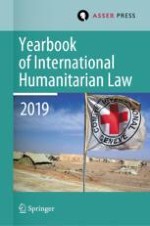2021 | OriginalPaper | Chapter
6. Not the Usual Suspects: Religious Leaders as Influencers of International Humanitarian Law Compliance
Authors : Ioana Cismas, Ezequiel Heffes
Published in: Yearbook of International Humanitarian Law, Volume 22 (2019)
Publisher: T.M.C. Asser Press
Activate our intelligent search to find suitable subject content or patents.
Select sections of text to find matching patents with Artificial Intelligence. powered by
Select sections of text to find additional relevant content using AI-assisted search. powered by
